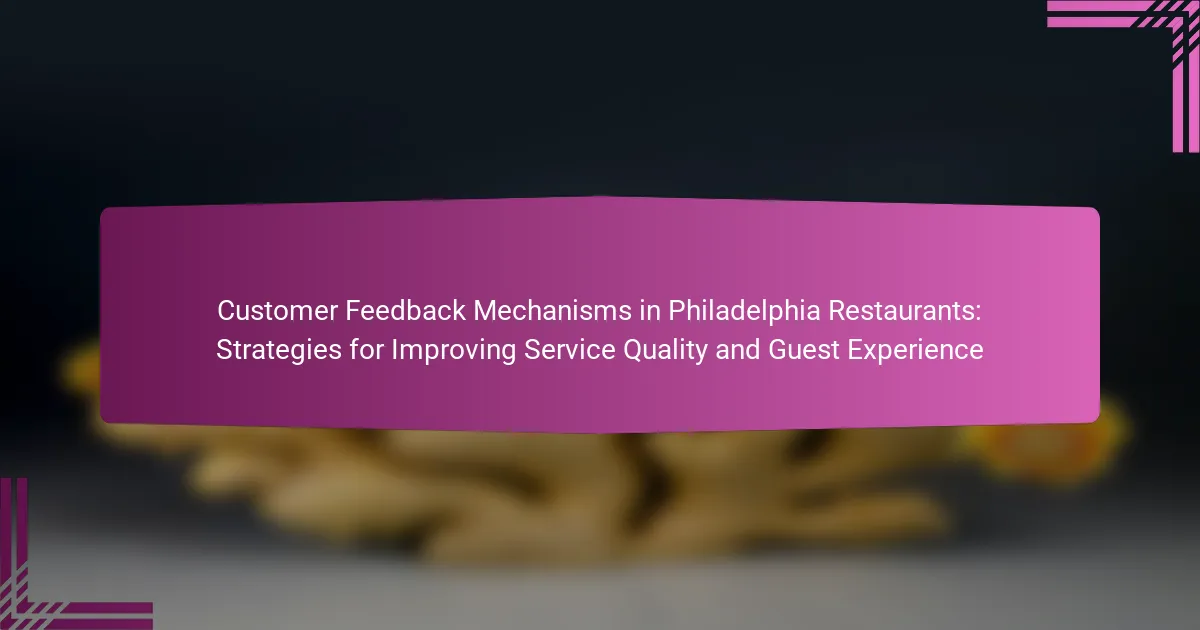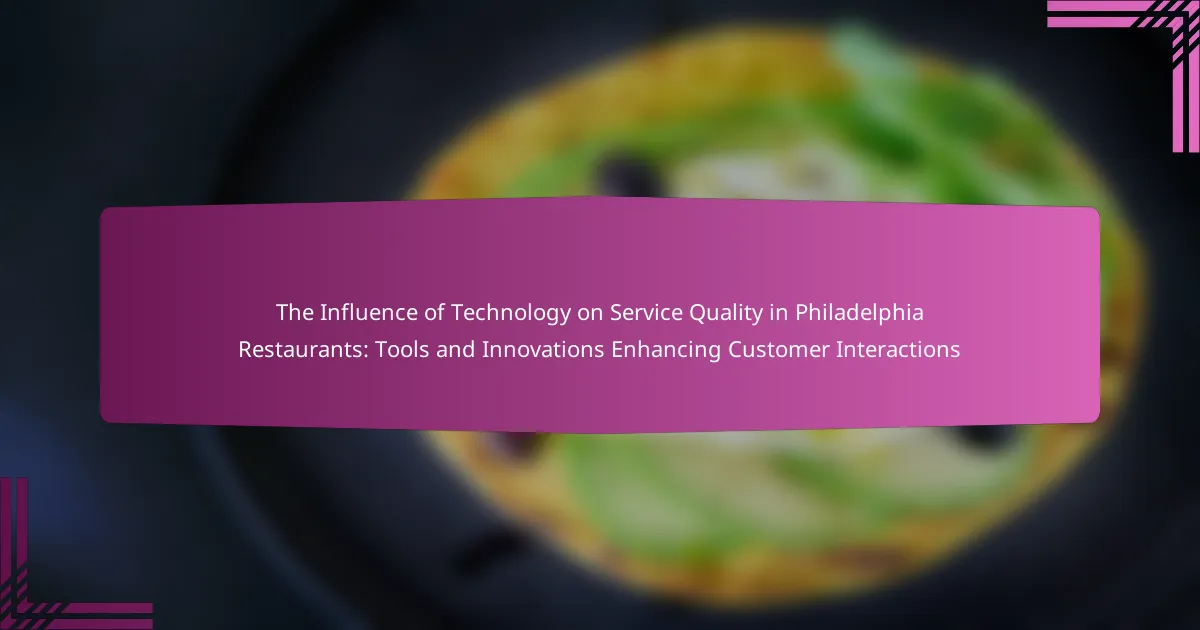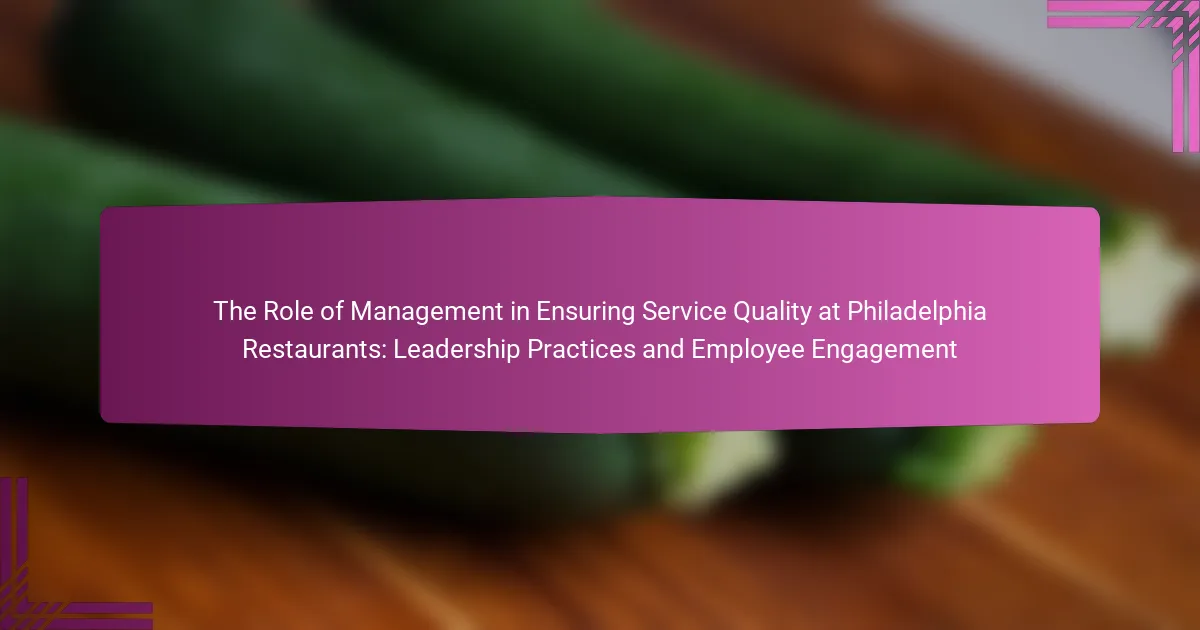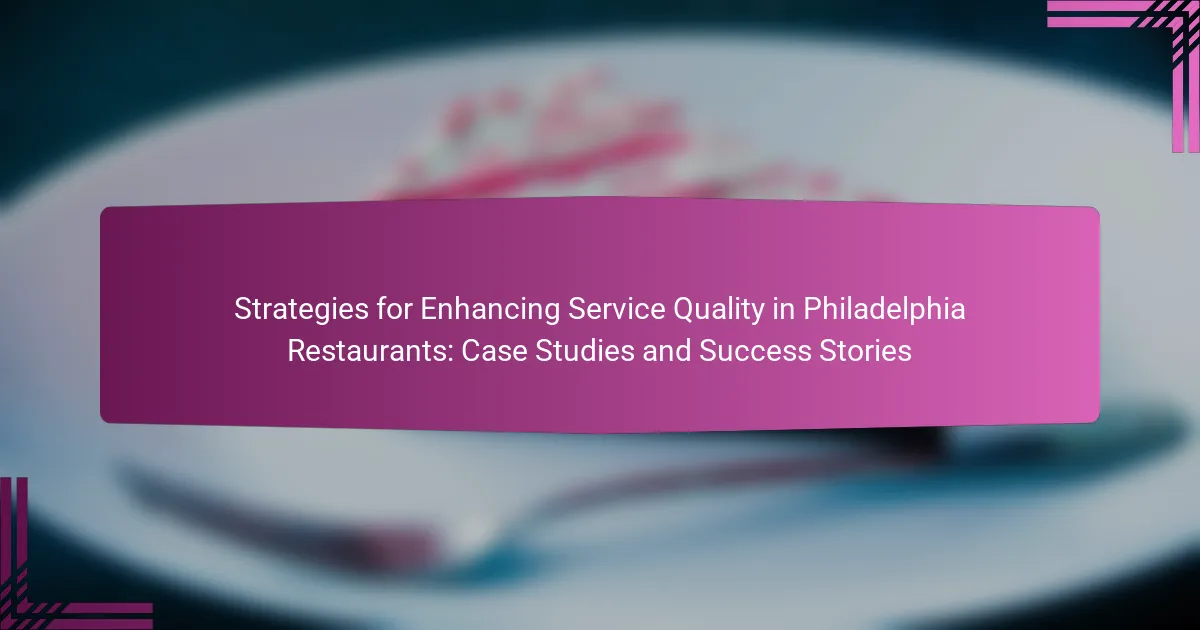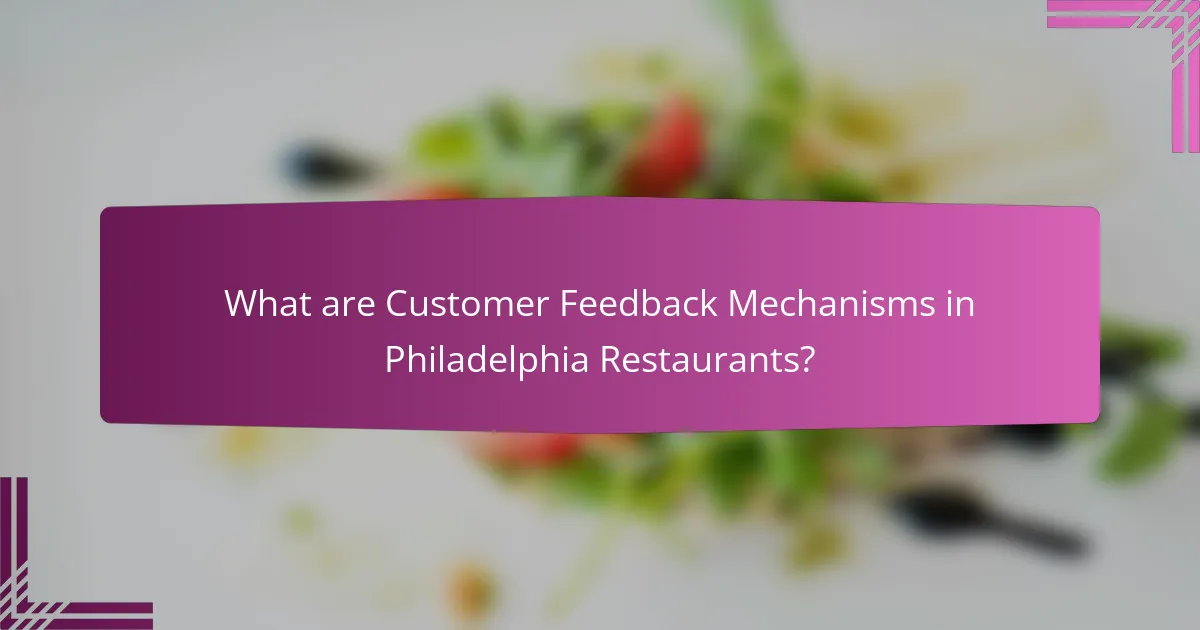
What are Customer Feedback Mechanisms in Philadelphia Restaurants?
Customer feedback mechanisms in Philadelphia restaurants include surveys, comment cards, and online reviews. These tools allow patrons to express their dining experiences. Surveys are often distributed after meals, either on paper or electronically. Comment cards are placed on tables for immediate feedback. Online reviews on platforms like Yelp and Google are widely utilized. Social media also serves as a channel for customer opinions. These mechanisms help restaurants identify strengths and areas for improvement. By analyzing feedback, restaurants can enhance service quality and guest experience.
How do these mechanisms contribute to service quality?
Customer feedback mechanisms enhance service quality by providing direct insights into guest experiences. These insights allow restaurants to identify areas needing improvement. For instance, feedback can highlight inconsistencies in service delivery. Addressing these issues leads to better customer satisfaction. Additionally, feedback fosters a culture of continuous improvement. Restaurants that actively seek and act on feedback often see increased customer loyalty. A study by the Harvard Business Review found that companies that prioritize customer feedback can enhance their service quality significantly. This correlation demonstrates the effectiveness of feedback mechanisms in improving overall service.
What types of feedback mechanisms are commonly used in restaurants?
Restaurants commonly use surveys, comment cards, online reviews, and direct communication as feedback mechanisms. Surveys are often distributed after meals to gather detailed insights. Comment cards are placed on tables for immediate feedback. Online reviews on platforms like Yelp provide broader public opinions. Direct communication occurs when staff engage with guests during their visit. These mechanisms allow restaurants to understand customer satisfaction and areas for improvement.
How do restaurants implement these feedback mechanisms?
Restaurants implement feedback mechanisms through various methods. They utilize comment cards placed on tables for immediate feedback. Digital surveys sent via email after dining experiences are also common. Some restaurants use social media platforms to engage with customers and gather opinions. Staff training emphasizes the importance of asking for customer feedback directly. Many establishments monitor online reviews to assess guest satisfaction. Technology, such as mobile apps, allows for real-time feedback collection. These methods help restaurants identify areas for improvement and enhance customer experiences. Research shows that 70% of customers are more likely to return if their feedback is acknowledged.
Why is customer feedback important for restaurants?
Customer feedback is important for restaurants because it directly influences service quality and customer satisfaction. It provides insights into customer preferences and expectations. Restaurants can identify strengths and weaknesses through this feedback. Positive feedback reinforces successful practices, while negative feedback highlights areas needing improvement. According to a study by the National Restaurant Association, 70% of customers consider feedback essential for enhancing their dining experience. This data demonstrates how feedback shapes menu offerings and service styles. Ultimately, effective use of customer feedback can lead to increased loyalty and repeat business.
How does customer feedback influence guest experience?
Customer feedback significantly influences guest experience by providing insights into customer satisfaction and preferences. Restaurants can identify areas for improvement through direct feedback from guests. This feedback can highlight specific service issues, menu preferences, or ambiance concerns. Addressing these issues leads to enhanced service quality. According to a study by the National Restaurant Association, 70% of diners are likely to return to a restaurant that listens to their feedback. Implementing changes based on feedback fosters a sense of value among customers. Satisfied guests often share their positive experiences, attracting new patrons. Thus, customer feedback directly shapes and enhances the overall guest experience.
What role does feedback play in improving service quality?
Feedback plays a critical role in improving service quality. It provides valuable insights into customer experiences and expectations. Restaurants can identify areas needing enhancement through direct feedback. This feedback can reveal specific service failures or strengths. For instance, a study by the Cornell University School of Hotel Administration found that customer feedback significantly correlates with service improvements. Restaurants that actively seek and respond to feedback see higher customer satisfaction rates. This process fosters a culture of continuous improvement. Ultimately, feedback helps restaurants align their services with customer needs, enhancing overall quality.
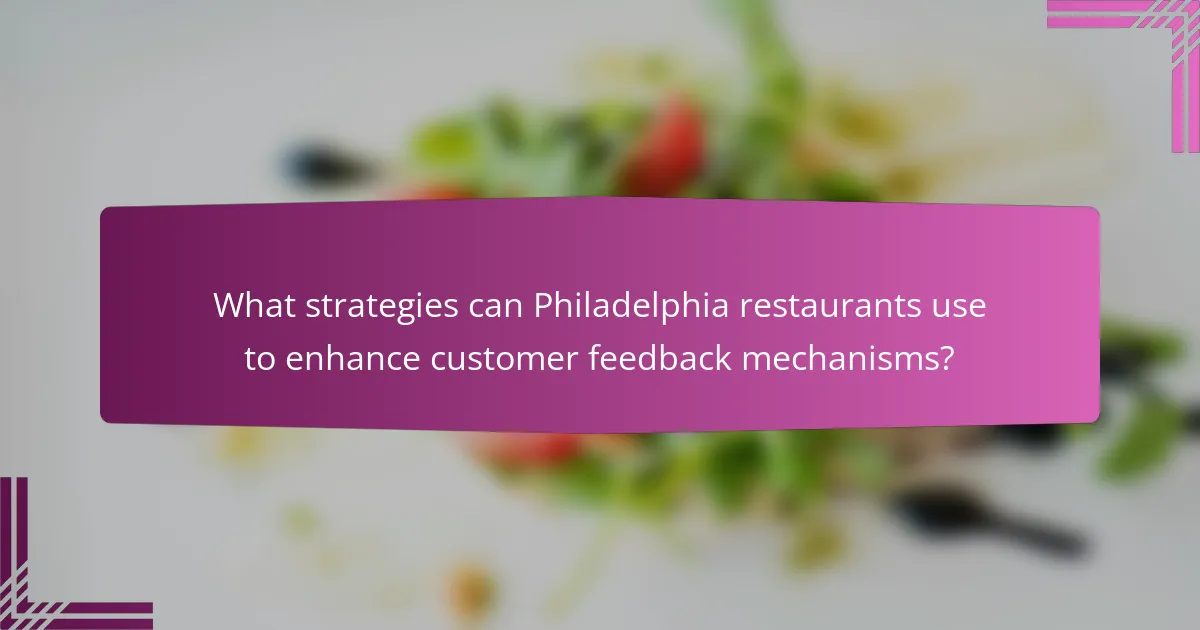
What strategies can Philadelphia restaurants use to enhance customer feedback mechanisms?
Philadelphia restaurants can enhance customer feedback mechanisms by implementing digital surveys, engaging with customers on social media, and utilizing comment cards. Digital surveys can be sent via email or text after dining, allowing immediate feedback. Engaging with customers on social media platforms encourages open dialogue and real-time feedback. Comment cards placed on tables provide an easy way for guests to share their thoughts during their visit. Additionally, training staff to actively solicit feedback during service can improve response rates. Offering incentives, such as discounts for completed surveys, can increase participation. These strategies foster a culture of continuous improvement and responsiveness to customer needs.
How can restaurants encourage more customer feedback?
Restaurants can encourage more customer feedback by implementing various strategies. Offering incentives, such as discounts or freebies, can motivate customers to share their opinions. Creating an easy-to-use feedback system, like digital surveys or comment cards, simplifies the process for customers. Actively engaging with customers during their visit can prompt immediate feedback. Training staff to ask for feedback at the end of the meal can also be effective. Promoting feedback opportunities through social media and email newsletters increases visibility. Displaying a commitment to addressing feedback shows customers their opinions are valued. Research indicates that 70% of customers are more likely to provide feedback if they believe it will lead to improvements.
What incentives can be offered to customers for providing feedback?
Incentives for customers providing feedback can include discounts on future purchases. Restaurants often offer a percentage off the next meal as a reward. Another common incentive is entry into a prize draw for a gift card. This encourages participation while giving customers a chance to win something valuable. Free menu items, such as appetizers or desserts, can also motivate feedback. Additionally, exclusive access to special events or promotions can be appealing. Research shows that these incentives increase response rates significantly. For example, a study by the Journal of Marketing found that offering a small incentive can double the likelihood of receiving customer feedback.
How can technology be utilized to gather feedback more effectively?
Technology can be utilized to gather feedback more effectively through digital surveys and mobile applications. These tools allow for immediate and convenient feedback collection from customers. Digital surveys can be sent via email or SMS after a dining experience. Mobile applications can prompt users to provide feedback while still engaged with the restaurant’s services.
Additionally, social media platforms can be leveraged for real-time feedback. Customers often share their experiences on these platforms, providing valuable insights. Online review sites also serve as a means for customers to express their opinions.
Data analytics tools can analyze feedback trends over time. This helps restaurants identify areas for improvement. Implementing these technologies can lead to higher response rates and more actionable insights. According to a study by the Harvard Business Review, businesses that utilize digital feedback tools see a 30% increase in customer response rates.
What are the best practices for analyzing customer feedback?
The best practices for analyzing customer feedback include systematically collecting data, categorizing responses, and identifying trends. First, utilize multiple channels for feedback collection, such as surveys, social media, and direct communication. This approach ensures a diverse range of opinions. Next, categorize the responses into themes like service quality, menu options, and ambiance. This helps in pinpointing specific areas for improvement.
After categorization, analyze the data for patterns over time. Look for recurring issues or positive comments that highlight strengths. Quantitative analysis can also be beneficial; for example, tracking satisfaction scores can reveal shifts in customer perception.
Lastly, act on the insights gained from the analysis. Implement changes based on feedback and communicate these changes to customers. This demonstrates that their opinions are valued and can lead to increased loyalty. Consistent application of these practices can significantly enhance the quality of service and guest experience in restaurants.
How can restaurants identify trends from customer feedback data?
Restaurants can identify trends from customer feedback data by systematically analyzing the collected information. They can utilize sentiment analysis tools to gauge customer emotions related to their dining experiences. By categorizing feedback into themes such as service quality, menu variety, and ambiance, restaurants can pinpoint specific areas for improvement.
Regularly monitoring feedback over time allows establishments to track changes in customer preferences. For instance, a rise in comments about plant-based menu options may indicate a growing demand for vegetarian dishes. Additionally, implementing surveys with targeted questions can yield quantitative data that highlights trends.
Using data visualization techniques can further clarify patterns in customer feedback. For example, charts and graphs can illustrate the frequency of specific comments or ratings over time. By combining qualitative and quantitative analysis, restaurants can make informed decisions to enhance service quality and guest experience.
What tools can assist in the analysis of feedback?
Survey tools like SurveyMonkey and Google Forms can assist in the analysis of feedback. These platforms allow users to create customized surveys to collect customer opinions. Analytics features help in interpreting the results effectively. Text analysis tools like MonkeyLearn can analyze open-ended feedback. They provide insights into customer sentiments and trends. Customer relationship management (CRM) systems like Salesforce also facilitate feedback analysis. They integrate customer data for comprehensive analysis. Additionally, social media monitoring tools like Hootsuite track customer feedback across platforms. They help in understanding customer perceptions in real-time. Each of these tools enhances the ability to analyze feedback efficiently.
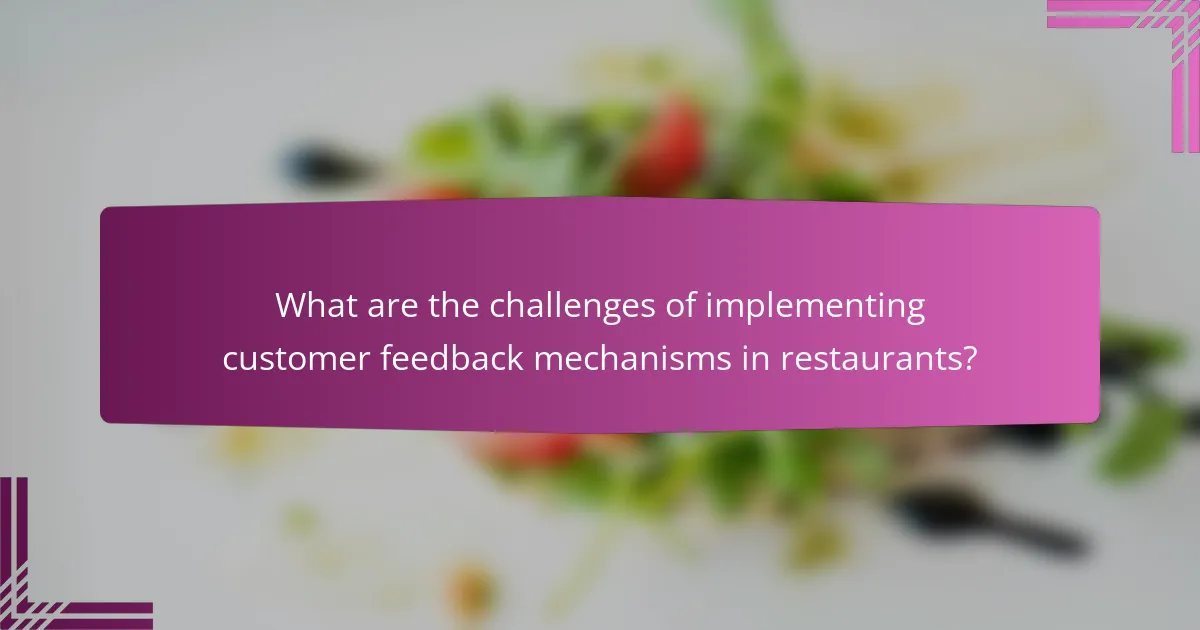
What are the challenges of implementing customer feedback mechanisms in restaurants?
Implementing customer feedback mechanisms in restaurants presents several challenges. One major challenge is the difficulty in obtaining honest feedback. Customers may hesitate to provide negative comments directly to staff. This can lead to skewed data that does not accurately reflect the dining experience.
Another challenge is the integration of feedback systems with existing operations. Many restaurants lack the technology or processes to effectively collect and analyze feedback. This can result in missed opportunities for improvement.
Additionally, staff may be resistant to feedback mechanisms. Employees might feel threatened by criticism, leading to a lack of engagement in the process.
Time constraints also pose a challenge. Restaurant staff are often busy, making it hard to prioritize feedback collection and analysis.
Finally, ensuring follow-up on feedback is crucial. Without proper follow-up, customers may feel their opinions are ignored, leading to disengagement.
These challenges highlight the complexities involved in effectively implementing customer feedback mechanisms in restaurants.
How can restaurants address common obstacles to feedback collection?
Restaurants can address common obstacles to feedback collection by implementing multiple strategies. First, they can simplify the feedback process. This includes using digital platforms for easy access. Second, they can train staff to actively solicit feedback. Engaging customers during their visit increases response rates. Third, offering incentives can motivate guests to share their opinions. Discounts or freebies encourage participation in surveys. Fourth, ensuring anonymity can make customers feel more comfortable sharing honest feedback. Lastly, analyzing feedback regularly and acting on it demonstrates that restaurants value customer input. According to a study by the National Restaurant Association, 70% of customers are more likely to return if they see their feedback implemented.
What strategies can mitigate negative feedback impact?
Implementing proactive communication strategies can mitigate negative feedback impact. Establishing a clear channel for customer concerns allows for immediate resolution. Training staff to handle feedback professionally fosters a positive atmosphere. Regularly monitoring online reviews helps identify issues early. Encouraging satisfied customers to leave positive reviews can balance negative ones. Personalizing responses to feedback shows customers their opinions are valued. Following up with customers after resolving issues can rebuild trust. According to a 2020 survey by ReviewTrackers, 53% of customers expect businesses to respond to negative reviews within a week.
How can restaurants ensure feedback is constructive and actionable?
Restaurants can ensure feedback is constructive and actionable by implementing structured feedback mechanisms. These mechanisms should include specific questions that guide customers to provide detailed responses. For example, asking about specific menu items or service interactions can yield valuable insights.
Additionally, staff training on how to solicit and interpret feedback is essential. Trained staff can ask open-ended questions that encourage customers to share their thoughts. This approach helps in understanding customer experiences better.
Moreover, analyzing feedback trends over time can identify recurring issues. Data analysis can reveal patterns that inform operational improvements. For instance, if multiple customers mention slow service, restaurants can address staffing or training needs.
Lastly, closing the feedback loop by communicating changes made based on customer input fosters trust. Customers appreciate knowing their opinions lead to tangible improvements. This practice not only enhances service quality but also boosts customer loyalty.
What practical tips can Philadelphia restaurants use to improve their feedback mechanisms?
Philadelphia restaurants can improve their feedback mechanisms by implementing digital feedback forms. These forms allow customers to provide input easily and quickly. Restaurants should also encourage feedback through staff interactions. Training staff to ask for feedback during service can yield valuable insights. Offering incentives, such as discounts or freebies, can motivate customers to share their experiences. Regularly reviewing feedback data helps identify trends and areas for improvement. Additionally, responding to feedback demonstrates that the restaurant values customer opinions. Utilizing social media platforms for feedback can engage a broader audience. Lastly, conducting periodic surveys can gather in-depth insights into customer satisfaction.
How can staff training enhance the feedback process?
Staff training can enhance the feedback process by equipping employees with the skills to effectively gather and interpret customer insights. Trained staff are more likely to engage with customers, leading to higher response rates in feedback collection. They can ask targeted questions that yield specific and actionable data. Additionally, training fosters a culture of open communication, encouraging staff to share feedback with management. This creates a loop where feedback is not only collected but also acted upon. Research indicates that organizations with well-trained staff see a 20% increase in customer satisfaction scores. Enhanced feedback processes ultimately lead to improved service quality and guest experiences.
What role does follow-up communication play in the feedback loop?
Follow-up communication plays a crucial role in the feedback loop by ensuring that customer feedback is acknowledged and addressed. It allows restaurants to demonstrate that they value customer opinions and are committed to improvement. Effective follow-up can lead to enhanced customer satisfaction and loyalty. Studies show that 70% of customers who receive follow-up communication after providing feedback feel more engaged with the brand. Moreover, follow-up communication can provide additional insights into customer experiences, helping restaurants to refine their services. This two-way communication fosters a culture of continuous improvement. Ultimately, follow-up communication closes the feedback loop, making customers feel heard and appreciated.
Customer feedback mechanisms in Philadelphia restaurants encompass various tools such as surveys, comment cards, online reviews, and direct communication, which enable patrons to express their dining experiences. These mechanisms are essential for identifying strengths and areas for improvement, ultimately enhancing service quality and guest satisfaction. The article explores the types of feedback mechanisms used, their implementation, and strategies to encourage customer participation, including the use of technology and incentives. It also addresses the challenges restaurants face in collecting feedback and offers best practices for analyzing and acting on customer insights to foster continuous improvement and build customer loyalty.
